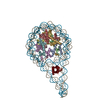+Search query
-Structure paper
| Title | Structure and Dynamics of a 197 bp Nucleosome in Complex with Linker Histone H1. |
|---|---|
| Journal, issue, pages | Mol Cell, Vol. 66, Issue 3, Page 384-397.e8, Year 2017 |
| Publish date | May 4, 2017 |
 Authors Authors | Jan Bednar / Isabel Garcia-Saez / Ramachandran Boopathi / Amber R Cutter / Gabor Papai / Anna Reymer / Sajad H Syed / Imtiaz Nisar Lone / Ognyan Tonchev / Corinne Crucifix / Hervé Menoni / Christophe Papin / Dimitrios A Skoufias / Hitoshi Kurumizaka / Richard Lavery / Ali Hamiche / Jeffrey J Hayes / Patrick Schultz / Dimitar Angelov / Carlo Petosa / Stefan Dimitrov /    |
| PubMed Abstract | Linker histones associate with nucleosomes to promote the formation of higher-order chromatin structure, but the underlying molecular details are unclear. We investigated the structure of a 197 bp ...Linker histones associate with nucleosomes to promote the formation of higher-order chromatin structure, but the underlying molecular details are unclear. We investigated the structure of a 197 bp nucleosome bearing symmetric 25 bp linker DNA arms in complex with vertebrate linker histone H1. We determined electron cryo-microscopy (cryo-EM) and crystal structures of unbound and H1-bound nucleosomes and validated these structures by site-directed protein cross-linking and hydroxyl radical footprinting experiments. Histone H1 shifts the conformational landscape of the nucleosome by drawing the two linkers together and reducing their flexibility. The H1 C-terminal domain (CTD) localizes primarily to a single linker, while the H1 globular domain contacts the nucleosome dyad and both linkers, associating more closely with the CTD-distal linker. These findings reveal that H1 imparts a strong degree of asymmetry to the nucleosome, which is likely to influence the assembly and architecture of higher-order structures. |
 External links External links |  Mol Cell / Mol Cell /  PubMed:28475873 / PubMed:28475873 /  PubMed Central PubMed Central |
| Methods | EM (single particle) / X-ray diffraction |
| Resolution | 5.4 - 11.4 Å |
| Structure data |  EMDB-3657:  EMDB-3659:  EMDB-3660:  PDB-5nl0: |
| Source |
|
 Keywords Keywords | CHROMATIN BINDING PROTEIN / DNA / nucleosome / chromatin / linker histones / histone H1 / CHROMATIN BINDING PROTEIN - DNA complex |
 Movie
Movie Controller
Controller Structure viewers
Structure viewers About Yorodumi Papers
About Yorodumi Papers



 Homo sapiens (human)
Homo sapiens (human)